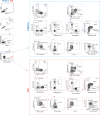Comparison of immunometabolic profiles in whole blood versus peripheral blood mononuclear cells
- PMID: 41230343
- PMCID: PMC12604536
- DOI: 10.1097/IN9.0000000000000073
Comparison of immunometabolic profiles in whole blood versus peripheral blood mononuclear cells
Abstract
Background: Immunometabolism has emerged as a flourishing field exploring how cellular metabolism regulates immune responses. Peripheral blood mononuclear cells (PBMCs) have so far been the primary sample type used for immunometabolic profiling. However, PBMCs isolation requires large blood volumes, can pose logistic challenges, and requires specialized skills for processing. Thus, using whole blood (WB) samples, which are less technically challenging to process, could serve as a viable alternative for metabolic characterization of circulating immune cell populations. Yet, how well WB immunometabolic profiles match those from PBMCs remains unknown. Therefore, we aimed to compare the immunometabolic profile of WB with that of PBMCs.
Method: Paired WB and PBMCs samples were collected from six healthy donors. WB was collected in CryoStor®-CS10 medium, while PBMCs were isolated using Ficoll density gradient. Using spectral flow cytometry, we identified immune cell populations and assessed their metabolic states.
Results: Our findings show an overall high similarity in the immune cell subset frequencies between WB and PBMCs as well as their metabolic profiles. However, differences in the expression of certain metabolic markers were noted in some immune populations. Specifically, glucose transporter 1 levels were higher in CD8+ TEMRA, NKT, and NK cells from PBMCs, while ATP5a levels were higher in naïve CD4+ T cells from WB.
Conclusions: These results suggest that WB can be an alternative to PBMCs for metabolic profiling of immune cells. Nevertheless, for some specific cell subsets, caution should be taken when comparing immunometabolic data between WB and PBMCs.
Keywords: immunometabolic profiling; metabolic markers; metabolism; peripheral blood mononuclear cells; spectral flow cytometry; whole blood.
Copyright © 2025 The Author(s), Published by Wolters Kluwer Health, Inc.
Conflict of interest statement
The authors declare that they have no conflict of interest.
Figures



References
-
- Brodin P, Duffy D, Quintana-Murci L. A call for blood—in human immunology. Immunity. 2019;50(6):1335-6. - PubMed
LinkOut - more resources
Full Text Sources
Research Materials
Miscellaneous
